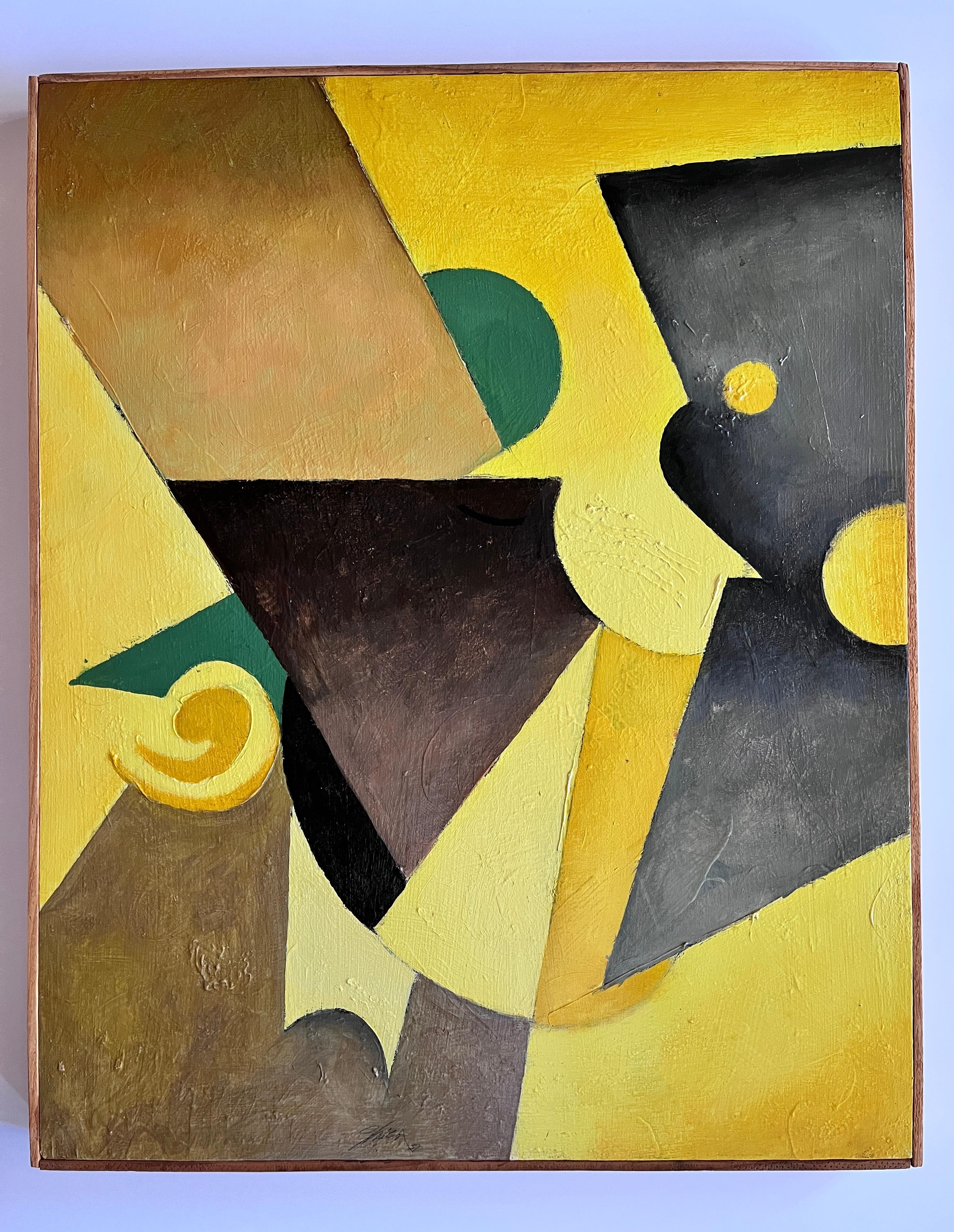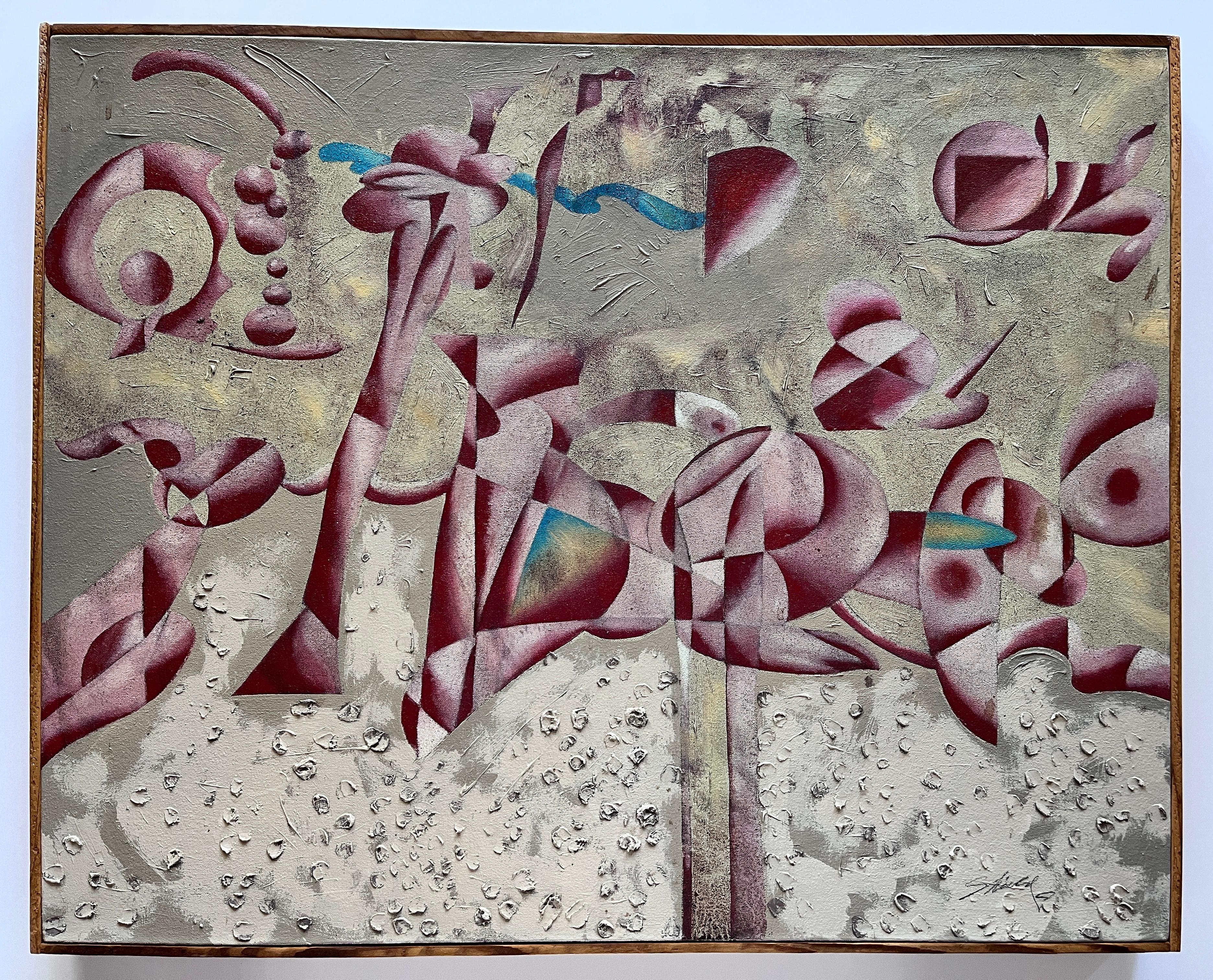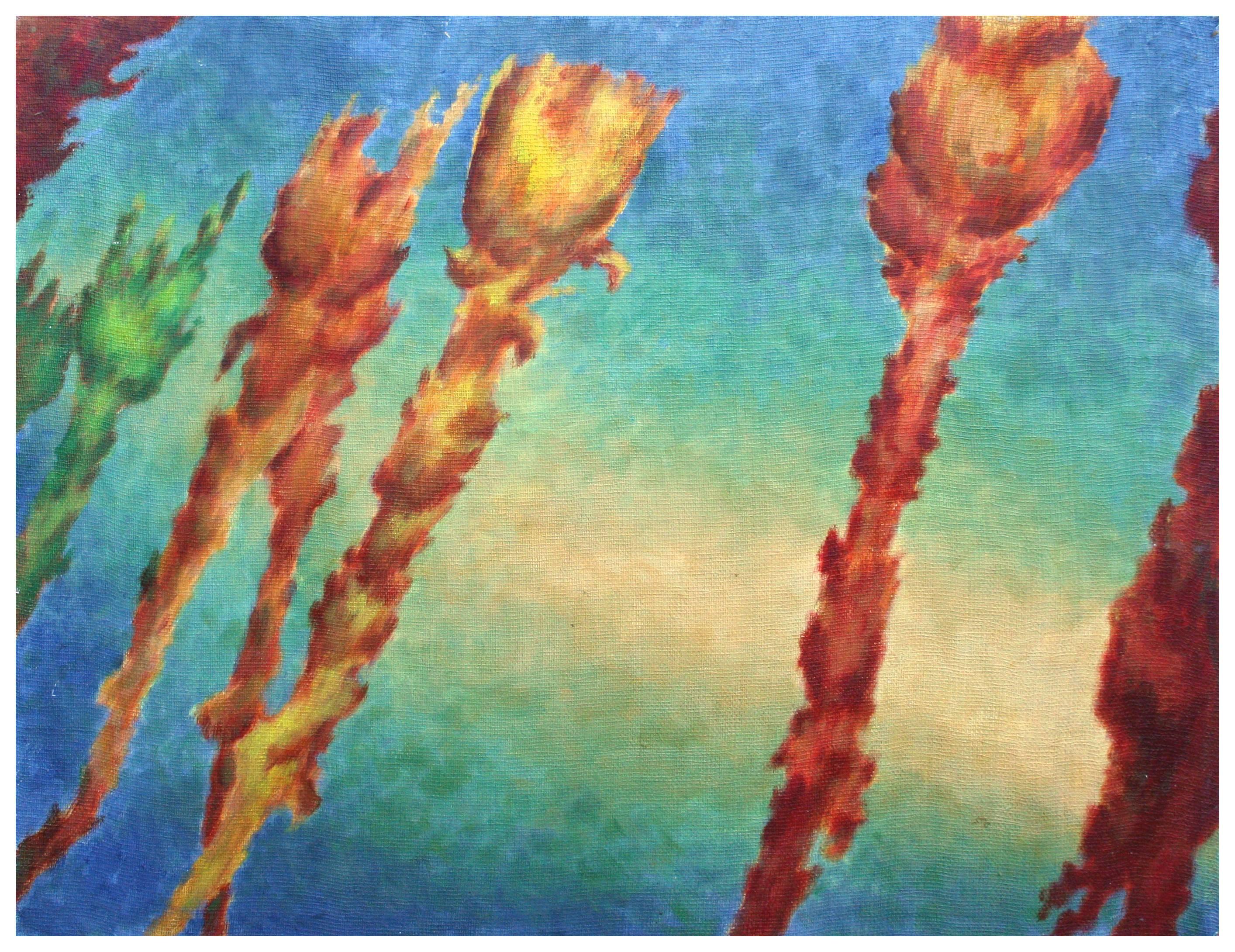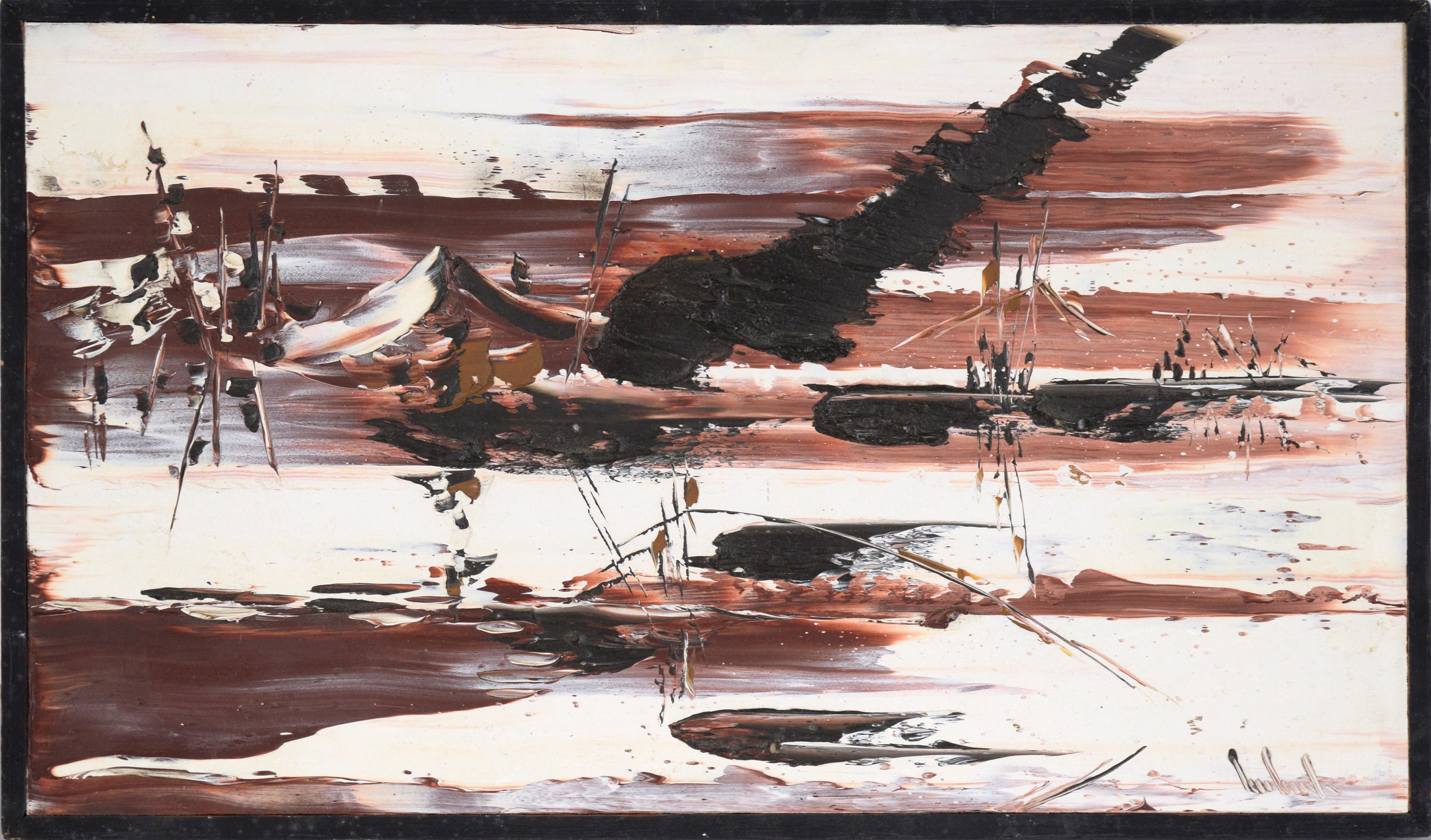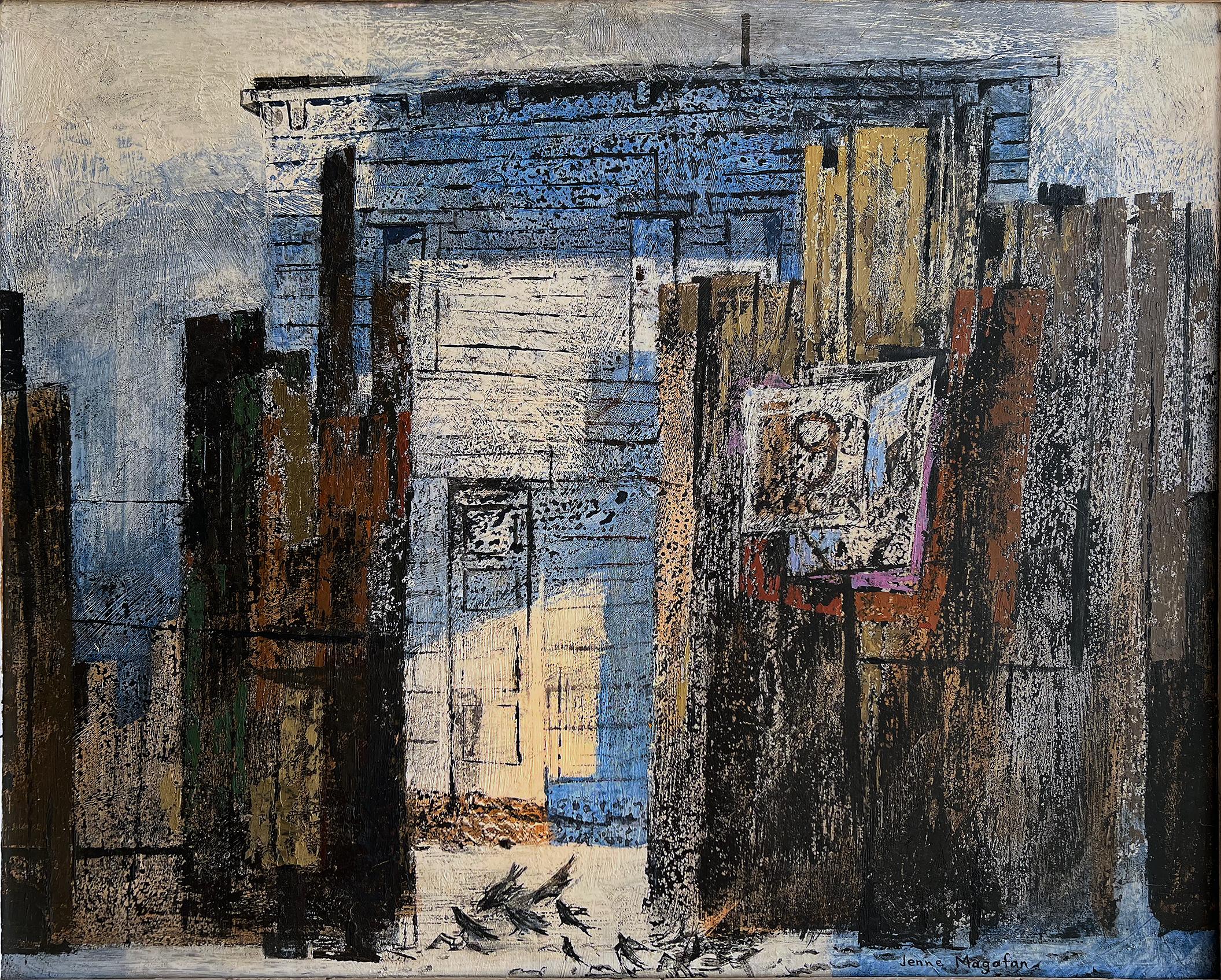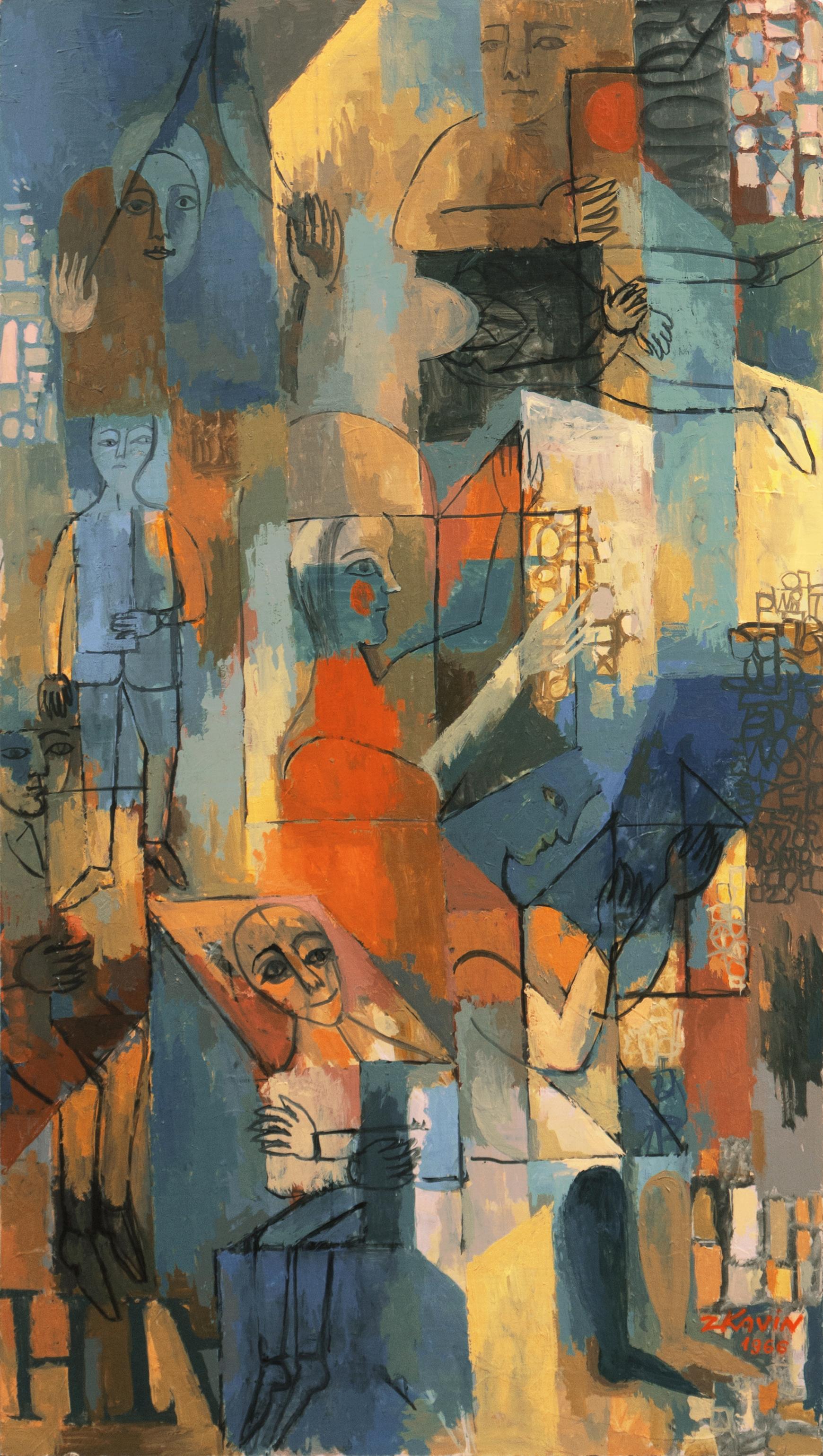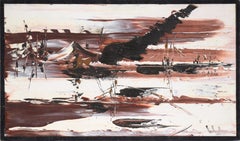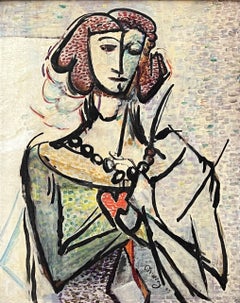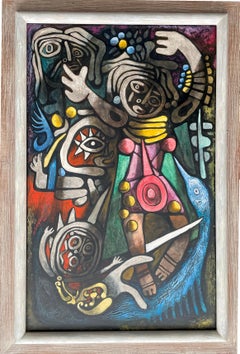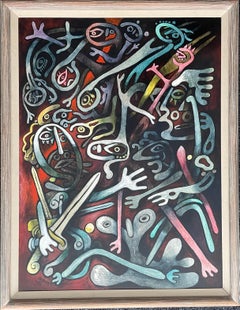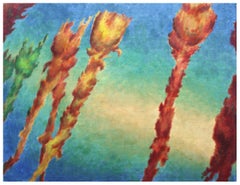
Botanical Abstract, Vintage 1970s Modern Floral
View Similar Items
Want more images or videos?
Request additional images or videos from the seller
1 of 9
Eleanor PerryBotanical Abstract, Vintage 1970s Modern Floral 1972
1972
About the Item
- Creator:Eleanor Perry (1928 - 2014, American)
- Creation Year:1972
- Dimensions:Height: 22 in (55.88 cm)Width: 28 in (71.12 cm)Depth: 1 in (2.54 cm)
- Medium:
- Movement & Style:
- Period:
- Condition:
- Gallery Location:Soquel, CA
- Reference Number:Seller: JT-S21671stDibs: LU5421566543
Eleanor Perry
Eleanor Perry (American, 1903-1996) was a San Francisco and Monterey artist, Exhibited California Art Club; listed in Artists in California 1786-1940 by Edan Hughes. Graduated from the University of California at Berkeley in 1923.
About the Seller
4.9
Platinum Seller
These expertly vetted sellers are 1stDibs' most experienced sellers and are rated highest by our customers.
Established in 1986
1stDibs seller since 2014
2,520 sales on 1stDibs
More From This SellerView All
- Botanical Abstract, Vintage 1970s Modern FloralBy Eleanor PerryLocated in Soquel, CABotanical Abstract, Vintage 1970s Modern Floral This vivid oil painting of flowers on a bright sunny day is a fresh modernist take on the botanical still-life. California artist El...Category
1970s Modern Abstract Paintings
MaterialsMasonite, Oil
- Mid Century Modern Abstracted Landscape in Oil on MasoniteLocated in Soquel, CAMid Century Modern Abstracted Landscape in Oil on Masonite Bold abstracted landscape by Ray Oakvick (American, 1917-1993). Streaks of reddish brown and white create an abstracted la...Category
1960s Modern Landscape Paintings
MaterialsOil, Masonite
$600 Sale Price20% Off - "Mr. Mute Mops Mouths Silent" - Whimsical Figurative in Acrylic on MasoniteLocated in Soquel, CA"Mr. Mute Mops Mouths Silent" - Whimsical Figurative in Acrylic on Masonite Bright figurative composition with a mime by Frances Mann (American, 20th Century). The figure in this pi...Category
Early 2000s Modern Figurative Paintings
MaterialsMasonite, Acrylic
- Modern Abstract Blue Rose, Vintage Abstracted Minimalist Floral by Eleanor PerryBy Eleanor PerryLocated in Soquel, CAModern Abstract Blue Rose, Vintage Abstracted Minimalist Floral by Eleanor Perry Modernist blue and white rose abstract by San Francisco, California artist Eleanor Louise Perry (Ame...Category
1970s Modern Abstract Paintings
MaterialsCanvas, Masonite, Acrylic
- Women and a Tiger Cub - Pop Art in Oil and Mixed Media on MasoniteLocated in Soquel, CAWomen and a Tiger Cub - Pop Art in Oil and Mixed Media on Canvas Pop art by George "Milo" Buck (American, b. 1952). In the center of the composition a woman is running to the left. ...Category
21st Century and Contemporary Pop Art Figurative Paintings
MaterialsGlitter, Oil, Masonite
- America Rising - Patriotic 9/11 Figurative AbstractBy Jocelyn AudetteLocated in Soquel, CAVivid and evocative abstracted painting of 9/11 by artist Jocelyn Audette (American, b. 1952), circa 2001. Impasto adds texture and interest. Label on verso with artist's name. Pres...Category
Early 2000s Abstract Expressionist Abstract Paintings
MaterialsMasonite, Oil
$680 Sale Price20% Off
You May Also Like
- Untitled (Cubist Portrait)By Jerre H. MurryLocated in Los Angeles, CAThis work is part of our exhibition - America Coast to Coast: Artists of the 1940s Untitled (Cubist Portrait), 1945, oil on masonite, signed and dated lower middle, 20 x 16 inches, remnant of exhibition label verso, perhaps exhibited at Murry's solo exhibition at the Los Angeles's Screen Cartoonists' Gallery, July , 1945, presented in its original frame Jerre Murry was a California modernist painter. Born in Columbia, Missouri, Murry studied at the Detroit Academy of Art and worked as an artist for the Detroit News and Detroit Free Press. Murry traveled to the Bahamas, where he was inspired to paint modernist scenes of island life and people. By the early 1930s, Murry had relocated to Los Angeles, where he caught the attention of Synchromist painter Stanton Macdonald Wright, State Supervisor for the Federal Art Project (FAP) in Southern California. MacDonald Wright enrolled Murry into the FAP. Murry’s Gauguin-influenced painting Sun Image was exhibited together with other FAP artists at the Los Angeles County Museum of Art in 1936, and Murry was also included in the FAP exhibit at the Paris Exposition in 1937. Stendahl Galleries in Los Angeles, the Chamber of Commerce Gallery in Santa Barbara, and at the Los Angeles County Museum of Art also showed Murry’s work during the 1930s. Murry created a murals for Los Angeles Water & Power Company, the Boise, Idaho Post Office, and Glendale Junior College. In 1939, Murry's work was exhibited at the Golden Gate International Exposition and the New York World's Fair. He also was included in the All California Exhibition at the Los Angeles County Museum of art that same year. He went on to exhibit in Los Angeles at the Foundation of Western Art's Trends in Southern California Art shows in 1940 and 1941, at Raymond and Raymond Gallery in Hollywood and USC’s Elizabeth Holmes...Category
1940s American Modern Paintings
MaterialsMasonite, Oil
- Ceremonial Dancers oil and tempera painting by Julio De DiegoBy Julio de DiegoLocated in Hudson, NYArtwork measures 48" x 30" and framed 56 ¼" x 38 ¼" x 3" Provenance: John Heller Gallery, NYC, circa 1975 (label verso) The artist's daughter Corbino Galleries, Sarasota, FL (1990)...Category
1940s Modern Abstract Paintings
MaterialsMasonite, Oil, Tempera
- The Magician oil and tempera painting by Julio de DiegoBy Julio de DiegoLocated in Hudson, NYJulio De Diego’s Atomic Series paintings made an extraordinary statement regarding the shock and fear that accompanied the dawn of the nuclear age. In the artist’s own words, “Scientists were working secretly to develop formidable powers taken from the mysterious depths of the earth - with the power to make the earth useless! Then, the EXPLOSION! . . . we entered the Atomic Age, and from there the neo-Atomic war begins. Explosions fell everywhere and man kept on fighting, discovering he could fight without flesh.” To execute these works, De Diego developed a technique of using tempera underpainting before applying layer upon layer of pigmented oil glazes. The result is paintings with surfaces which were described as “bonelike” in quality. The forms seem to float freely, creating a three-dimensional visual effect. In the 1954 book The Modern Renaissance in American Art, author Ralph Pearson summarizes the series as “a fantastic interpretation of a weighty theme. Perhaps it is well to let fantasy and irony appear to lighten the devastating impact. By inverse action, they may in fact increase its weight.” Exhibited 1964 Marion Koogler McNay Art Institute, San Antonio, Texas This work retains its original frame which measures 54" x 42" x 2" About this artist: Julio De Diego crafted a formidable persona within the artistic developments and political struggles of his time. The artist characterized his own work as “lyrical,” explaining, “through the years, the surrealists, the social-conscious painters and the others tried to adopt me, but I went my own way, good, bad or indifferent.” [1] His independence manifested early in life when de Diego left his parent’s home in Madrid, Spain, in adolescence following his father’s attempts to curtail his artistic aspirations. At the age of fifteen he held his first exhibition, set up within a gambling casino. He managed to acquire an apprenticeship in a studio producing scenery for Madrid’s operas, but moved from behind the curtains to the stage, trying his hand at acting and performing as an extra in the Ballet Russes’ Petrouchka with Nijinsky. He spent several years in the Spanish army, including a six-month stretch in the Rif War of 1920 in Northern Africa. His artistic career pushed ahead as he set off for Paris and became familiar with modernism’s forays into abstraction, surrealism, and cubism. The artist arrived in the U.S. in 1924 and settled in Chicago two years later. He established himself with a commission for the decoration of two chapels in St. Gregory’s Church. He also worked in fashion illustration, designed magazine covers and developed a popular laundry bag for the Hotel Sherman. De Diego began exhibiting through the Art Institute of Chicago in 1929, and participated in the annual Chicago Artists Exhibitions, Annual American Exhibitions, and International Water Color Exhibitions. He held a solo exhibition at the Art Institute of Chicago in the summer of 1935. Though the artist’s career was advancing, his family life had deteriorated. In 1932 his first marriage dissolved, and the couple’s young daughter Kiriki was sent to live with friend Paul Hoffman. De Diego continued to develop his artistic vocabulary with a growing interest in Mexican art. He traveled throughout the country acquainting himself with the works of muralists such as Carlos Merida, and also began a collection of small native artifacts...Category
1940s American Modern Abstract Paintings
MaterialsMasonite, Oil, Tempera
- St. Atomic oil and tempera painting by Julio de DiegoBy Julio de DiegoLocated in Hudson, NYJulio De Diego’s Atomic Series paintings made an extraordinary statement regarding the shock and fear that accompanied the dawn of the nuclear age. In the artist’s own words, “Scientists were working secretly to develop formidable powers taken from the mysterious depths of the earth - with the power to make the earth useless! Then, the EXPLOSION! . . . we entered the Atomic Age, and from there the neo-Atomic war begins. Explosions fell everywhere and man kept on fighting, discovering he could fight without flesh.” To execute these works, De Diego developed a technique of using tempera underpainting before applying layer upon layer of pigmented oil glazes. The result is paintings with surfaces which were described as “bonelike” in quality. The forms seem to float freely, creating a three-dimensional visual effect. In the 1954 book The Modern Renaissance in American Art, author Ralph Pearson summarizes the series as “a fantastic interpretation of a weighty theme. Perhaps it is well to let fantasy and irony appear to lighten the devastating impact. By inverse action, they may in fact increase its weight.” Exhibited 1950 University of Illinois at Urbana "Contemporary American Painting" 1964 Marion Koogler McNay Art Institute, San Antonio, Texas This work retains its original frame which measures 54" x 36" x 2". About this artist: Julio De Diego crafted a formidable persona within the artistic developments and political struggles of his time. The artist characterized his own work as “lyrical,” explaining, “through the years, the surrealists, the social-conscious painters and the others tried to adopt me, but I went my own way, good, bad or indifferent.” [1] His independence manifested early in life when de Diego left his parent’s home in Madrid, Spain, in adolescence following his father’s attempts to curtail his artistic aspirations. At the age of fifteen he held his first exhibition, set up within a gambling casino. He managed to acquire an apprenticeship in a studio producing scenery for Madrid’s operas, but moved from behind the curtains to the stage, trying his hand at acting and performing as an extra in the Ballet Russes’ Petrouchka with Nijinsky. He spent several years in the Spanish army, including a six-month stretch in the Rif War of 1920 in Northern Africa. His artistic career pushed ahead as he set off for Paris and became familiar with modernism’s forays into abstraction, surrealism, and cubism. The artist arrived in the U.S. in 1924 and settled in Chicago two years later. He established himself with a commission for the decoration of two chapels in St. Gregory’s Church. He also worked in fashion illustration, designed magazine covers and developed a popular laundry bag for the Hotel Sherman. De Diego began exhibiting through the Art Institute of Chicago in 1929, and participated in the annual Chicago Artists Exhibitions, Annual American Exhibitions, and International Water Color Exhibitions. He held a solo exhibition at the Art Institute of Chicago in the summer of 1935. Though the artist’s career was advancing, his family life had deteriorated. In 1932 his first marriage dissolved, and the couple’s young daughter Kiriki was sent to live with friend Paul Hoffman. De Diego continued to develop his artistic vocabulary with a growing interest in Mexican art. He traveled throughout the country acquainting himself with the works of muralists such as Carlos Merida, and also began a collection of small native artifacts...Category
1940s American Modern Abstract Paintings
MaterialsMasonite, Oil, Tempera
- Inevitable Day – Birth of the Atom oil and tempera painting by Julio De DiegoBy Julio de DiegoLocated in Hudson, NYJulio De Diego’s Atomic Series paintings made an extraordinary statement regarding the shock and fear that accompanied the dawn of the nuclear age. In the artist’s own words, “Scientists were working secretly to develop formidable powers taken from the mysterious depths of the earth - with the power to make the earth useless! Then, the EXPLOSION! . . . we entered the Atomic Age, and from there the neo-Atomic war begins. Explosions fell everywhere and man kept on fighting, discovering he could fight without flesh.” To execute these works, De Diego developed a technique of using tempera underpainting before applying layer upon layer of pigmented oil glazes. The result is paintings with surfaces which were described as “bonelike” in quality. The forms seem to float freely, creating a three-dimensional visual effect. In the 1954 book The Modern Renaissance in American Art, author Ralph Pearson summarizes the series as “a fantastic interpretation of a weighty theme. Perhaps it is well to let fantasy and irony appear to lighten the devastating impact. By inverse action, they may in fact increase its weight.” Bibliography Art in America, April 1951, p.78 About this artists: Julio De Diego crafted a formidable persona within the artistic developments and political struggles of his time. The artist characterized his own work as “lyrical,” explaining, “through the years, the surrealists, the social-conscious painters and the others tried to adopt me, but I went my own way, good, bad or indifferent.” [1] His independence manifested early in life when de Diego left his parent’s home in Madrid, Spain, in adolescence following his father’s attempts to curtail his artistic aspirations. At the age of fifteen he held his first exhibition, set up within a gambling casino. He managed to acquire an apprenticeship in a studio producing scenery for Madrid’s operas, but moved from behind the curtains to the stage, trying his hand at acting and performing as an extra in the Ballet Russes’ Petrouchka with Nijinsky. He spent several years in the Spanish army, including a six-month stretch in the Rif War of 1920 in Northern Africa. His artistic career pushed ahead as he set off for Paris and became familiar with modernism’s forays into abstraction, surrealism, and cubism. The artist arrived in the U.S. in 1924 and settled in Chicago two years later. He established himself with a commission for the decoration of two chapels in St. Gregory’s Church. He also worked in fashion illustration, designed magazine covers and developed a popular laundry bag for the Hotel Sherman. De Diego began exhibiting through the Art Institute of Chicago in 1929, and participated in the annual Chicago Artists Exhibitions, Annual American Exhibitions, and International Water Color Exhibitions. He held a solo exhibition at the Art Institute of Chicago in the summer of 1935. Though the artist’s career was advancing, his family life had deteriorated. In 1932 his first marriage dissolved, and the couple’s young daughter Kiriki was sent to live with friend Paul Hoffman. De Diego continued to develop his artistic vocabulary with a growing interest in Mexican art. He traveled throughout the country acquainting himself with the works of muralists such as Carlos Merida, and also began a collection of small native artifacts...Category
1940s American Modern Abstract Paintings
MaterialsMasonite, Oil, Tempera
- "Yellow Dialogue" Abstract Oil on Board Award Winning Illustrator Bill ShieldsLocated in Arp, TXBill Shields "Yellow Dialogue" c.1970 Oil on masonite Artist's wood frame 24"x2"x30" Signed in paint lower right Excellent Condition - Minor wear consistent with age and history. CV EDUCATION: Chicago Academy Of Fine Art San Antonio Art Institute MAJOR FIELDS OF PROFESSIONAL ENDEAVOR: Freelance graphic design and illustration Instructor of painting and illustration Landscape, figurative and abstract painting ART RELATED EMPLOYMENT: (Professor of Art) California College of Arts and Crafts, Oakland, CA Academy of Art College, San Francisco, CA San Francisco Art Institute San Jose State University AWARDS FOR ILLUSTRATION, Gold Medals: New York Society of Illustrators Los Angeles Society of Illustrators San Francisco Society of Illustrators Dallas-Fort Worth Art Director's Club Houston Artist's Guild BIBLIOGRAPHY: Feature articles in: American Artist, Communication Arts, Print, North Light. Architectural design featured in: Better Homes and Gardens, American Home, Sunset Magazine, Architectural Digest. ILLUSTRATION CLIENTS: Oil Companies: Champlin Oil Company, Mobil Oil Company, Continental Oil Company, Standard Oil Company, Humble Oil and Refining Company. Industrial: Hughes Tool Company, General Electric, United States Steel, Phelps Dodge, Sylvania Television, Texas Gulf Sulphur, Litton Industries, Houston Lighting and Power Company, International Business Machines. Institutional: National Aeronautics and Space Administration, United States Air Force, United States Department of the Interior, American Petroleum Institute, New York Stock Exchange, National Broadcasting Company, American Iron and Steel Institute, CBS Broadcasting Company, Vanguard Recording Company, Diners Club, Stanford Research Institute, Victoria Station, Neiman Marcus, Bank of America, Automobile Club of Southern California, Airlines: TWA, British West Indies Airlines, Pan American Airlines...Category
Mid-20th Century American Modern Abstract Paintings
MaterialsOil, Masonite
Recently Viewed
View AllMore Ways To Browse
Vintage Modern Art
1970s Modern Art
Modern Floral
Floral Art Modern
Botanical Art
Botanic Art
Art Botanical
1970s Modern Painting
Vintage Modern Art Paintings
Modern Botanicals
Botanicals Unframed
California Art Club
Floral Botanicals
Botanical Images
Botanic Vintage
Vintage Botanical
Abstract Modern Flowers
Vintage Modern Abstract Painting





